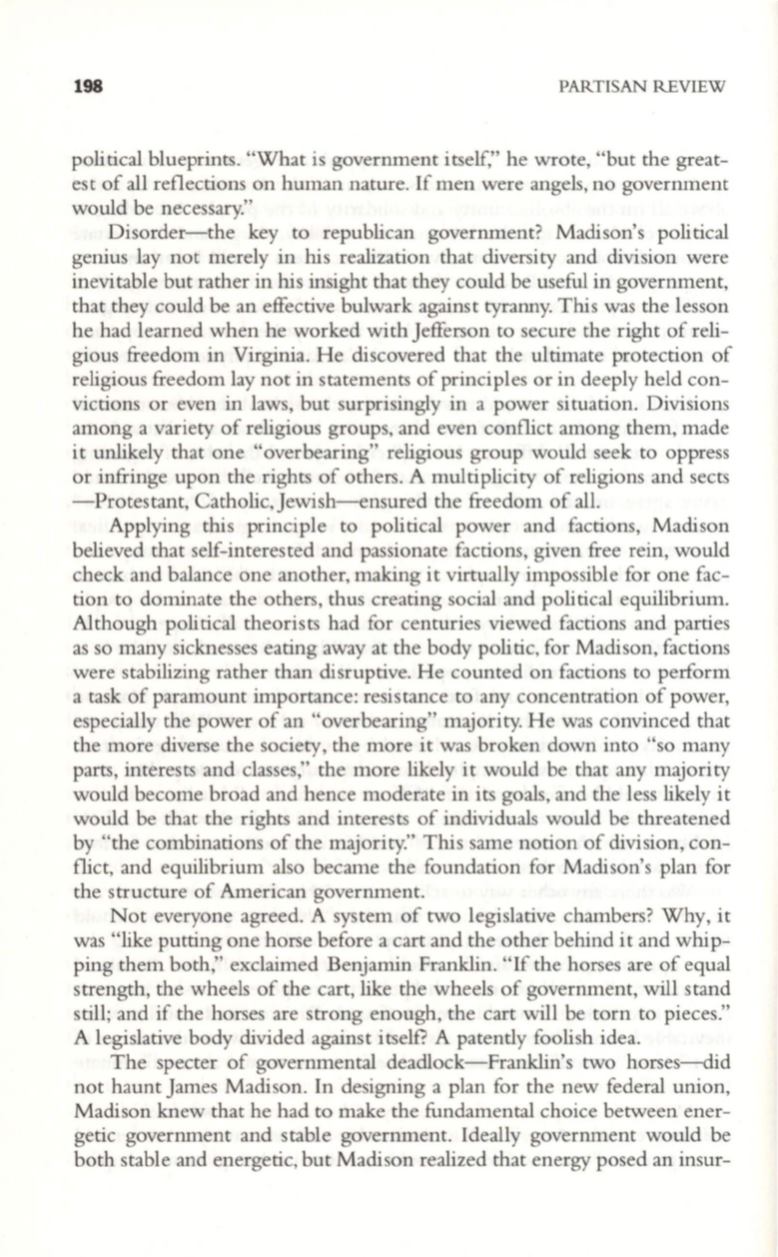
198
PARTISAN REVIEW
political blueprints. "What is government itself," he wrote, "but the great–
est of all reflections on human nature. If men were angels, no government
would be necessary."
Disorder-the key to republican government? Madison's political
genius lay not merely in his realization that diversity and division were
inevitable but rather in his insight that they could be useful in government,
that they could be an effective bulwark against tyranny. This was the lesson
he had learned when he worked with jefferson to secure the right of reli–
gious freedom in Virginia. He discovered that the ultimate protection of
religious freedom lay not in statements of principles or in deeply held con–
victions or even in laws, but surprisingly in a power situation. Divisions
among a variety of religious groups, and even conflict among them, made
it unlikely that one "overbearing" religious group would seek to oppress
or infringe upon the rights of others. A multiplicity of religions and sects
-Protestant, Catholic, jewish-ensured the freedom of all.
Applying this principle to political power and factions, Madison
believed that self-interested and passionate factions, given free rein, would
check and balance one another, making it virtually impossible for one fac–
tion to dominate the others, thus creating social and political equilibrium.
Although political theorists had for centuries viewed factions and parties
as so many sicknesses eating away at the body politic, for Madison, factions
were stabilizing rather than disruptive. He counted on factions to perform
a task of paramount importance: resis tance to any concentration of power,
especially the power of an "overbearing" majority. He was convinced that
the more diverse the society, the more it was broken down into "so many
parts, interests and classes," the more likely it would be that any majority
would become broad and hence moderate in its goals, and the less likely it
would be that the rights and interests of individuals would be threatened
by "the combinations of the majority." This same notion of division, con–
flict, and equilibrium also becanle the foundation for Madison's plan for
the structure of American government.
Not everyone agreed. A system of two legislative chambers? Why, it
was "like putting one horse before a cart and the other behind it and whip–
ping them both," exclaimed Benjamin Franklin. "If the horses are of equal
strength, the wheels of the cart, like the wheels of government, will stand
still; and if the horses are strong enough, the cart will be torn to pieces."
A legislative body divided against itself? A patently foolish idea.
The specter of governmental deadlock-Franklin's two horses-did
not haunt james Madison. In designing a plan for the new federal union,
Madison knew that he had to make the fundamental choice between ener–
getic government and stable government. Ideally government would be
both stable and energetic, but Madison realized that energy posed an insur-


